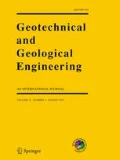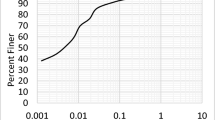Abstract
The undrained shear strength and consolidation characteristics for both remolded and stabilized soil are required in many geotechnical applications. In this paper a comprehensive laboratory work was carried out on cement-stabilized cohesive soil. The undrained shear strength of both untreated and treated soil at different consistency indices particularly at liquid and plastic limits has been determined based on direct and reverse extrusion tests. Furthermore, a series of oedometer test was performed in order to estimate the consolidation characteristics in terms of compression index, swelling index and yield stress of cement-stabilized soil in comparison to untreated soil. Three different soils available in Upper Egypt were extensively used under the influence of four different cement contents. Besides, the effect of curing period on soil strength and the variation of soil water content during treatment were also presented. The laboratory results were used to establish nonlinear regression formula for untreated soil combining the consistency index and undrained shear strength. The results indicated, through the variation of parameters, that the soil strength due to cement stabilization ranges between 152 and 625 times that for untreated soil at liquid limit. In addition, compression index for treatment soil decreased by about 92% to 37%.
















Similar content being viewed by others
References
Abiodun AA, Nalbantoglu Z (2017) A Laboratory model study on the performance of lime pile application for marine soils. Mar Georesour Geotechnol 35(3):397–644
Aboukhadra A, Zidan AF, Gaber Y (2018) Evaluation of strength behaviour of different Egyptian soils using enzymatic stabilizers. Cogent Eng 5:1–11
Arrowsmith EJ (1978) Roadwork fills—a material engineer’s viewpoint. In: Proceedings of the clay fills conference, institution of civil engineers, London, pp 25–36.
Baghdadi ZA, Fatani MN, Sabban NA (1995) Soil modification by cement kiln dust. J Mater Civ Eng ASCE 7(4):218–222
Balkıs AP, Macid S (2019) Effect of cement amount on CBR values of different soil. Eur J Sci Technol 16: 809–815. 10.31590/ejosat.588990
Bergado DT, Jamsawang P, Tanchaisawat T, Lai YP, Lorenzo GA (2008) Performance of reinforced load transfer platforms for embankments supported by deep cement mixing piles. In: GeoCongress 2008: Geosustainability and Geohazard Mitigation, pp 628–637
Bouassida M, Porbaha A (2004) Ultimate bearing capacity of soft clays reinforced by a group of columns-application to a deep mixing technique. Soils Found 44(3):91–101
Chai JC, Shrestha S, Hino T, Ding WQ, Kamo Y, Carter J (2015) 2D and 3D analyses of an embankment on clay improved by soil-cement columns. Comput Geotech 68:28–37
Daniel R, Raquel N, Rafaela C (2016) Influence of water content in the UCS of soil-cement mixtures for different cement dosages. Procedia Eng 143:59–66
Dennehy JP (1978) The remoulded undrained shear strength of cohesive soils and its influence on the suitability of embankment fill. In: Proceedings of the clay fills conference, institution of civil engineers, London, pp 87–94
Eades JL, Grim RE (1960) Reactions of hydrated lime with pure clay minerals in soil stabilization. High Res Bull 262:51–63
Gyanen T, Savitha AL, Krishna G (2013) Laboratory study on soil stabilization using fly ash mixtures. Int J Eng Sci Innov Technol 2(1):477–482
Imran MS, Gary KF, Michael PE (2007) Innovation in cement stabilisation of airfield subgrades. In: Proceedings of FAA worldwide airport technology transfer conference, Atlantic City, pp 6–8.
Johnson W, Kudo H (1962) The mechanics of metal extrusion. Manchester University Press, Manchester
Johnson W, Mellor PB (1962) Plasticity for mechanical engineers. Van Nostrand, London
Kayabali K, Tufenkci OO (2010) Shear strength of remolded soils at consistency limits. Can Geotechn J 47:259–266
Khan LI, Sarker M (1993) Enzyme enhanced stabilization of soil and fly ash. ASCE 36:43–58
Khandaker M, Anwar H (2011) Stabilized soils incorporating combinations of rice husk ash and cement Kiln dust. J Mater Civ Eng ASCE 23(9):1320–1327
Kvalstad TJ, Farrokh N, Kaynia AM, Mokkelbost KH, Byrn P (2005) Soil conditions and slope stability in the ormen large area. Mar Pet Geol 22(1–2):299–310
Lorenzo GA, Bergado DT (2004) Fundamental parameters of cement-admixed clay-new approach. Geotech Geoenviron Eng 130(10):1042–1050
Medhat F, Whyte IL (1986) An appraisal of soil index tests. In: Engineering geology special publication, geological society, London, pp 317–323.
Muir-Wood D (1990) Soil behaviour and critical state soil mechanics. Cambridge University Press
Nagaraj HB, Sridharan A, Mallikarjuna HM (2012) Re-examination of undrained strength at Attergerg limits water contents. Geotech Geol Eng 30:727–736
O’Kelly BC (2013) Atterberg limits and remolded strength-water content relationships. Geotech Test J 36(6):939–947
Saeed KA, Kassim KA, Hadi Nur H (2014) Physicochemical characterization of cement treated kaolin clay GRAĐEVINAR 66(6):513–521. 10.14256/JCE.976.2013
Sharma B, Bora PK (2003) Plastic limit, liquid limit and undrained shear strength of soil—reappraisal. J Geotech Geoenviron Eng ASCE 129(8):774–777
Shrestha R (2008) Soil mixing: a study on Brusselian sand mixed with slag cement binder, (unpublished master’s thesis). University of Ghent, Belgium
Skempton AW, Northey RD (1953) The sensitivity of clays. Geotechnique 3:30–53
Skopek J, Ter-Stepanian G (1975) Comparison of liquid limit values determined according to Casagrande and Vasilev. Geotechnique 25(1):135–136
Sridharan A, Abraham BM, Jose BT (1991) Improved technique for estimation of preconsolidation pressure. Geotechnique 41(2):263–268
Tay JH (1987) Sludge ash as filler for portland cement. J Environ Eng ASCE 113:345–435
Timar A (1974) Testing the plastic properties of cohesive and intermediate type soils by extrusion. Acta Technica ASH 76(3–4):355–370
Uddin K, Balasubramaniam AS, Bergado DT (1997) Engineering behavior of cement treated bangkok soft clay. Geotech Eng 28(1):89–121
Wang O, Altabbaa A (2012) Correlation of laboratory strength measurements of cement-stabilized soils. In: Proceeding in international conference on ground improvement and ground control, vol II, Research Publishing, Wollongong, New South Wales.
Wang ZF, Bian X, Wang Y (2017) Numerical approach to predict ground displacement caused by installing a horizontal jet grout column. Mar Georesour Geotechnol 35(7):970–977
Whyte IL (1982) Soil plasticity and strength—a new approach using extrusion. Ground Eng 15(1):16–24
Wroth CP, Wood DM (1978) The correlation of index properties with some basic engineering properties of soils. Can Geotech J 15(2):137–145
Yafrate NJ, DeJong JT (2005) Considerations in evaluating the remoulded undrained shear strength from full flow penetrometer cycling. In: Proceedings of frontiers in offshore geotechnics, Australia, (pp 19–21) Perth. Edited by S. Gourvenec and M. Cassidy. Taylor and Francis Group, London., pp 991–997
Yafrate NJ, DeJong JT, DeGroot DJ (2007) The influence of full-flow penetrometer area ratio on undrained strength measurements. In: Proceeding in 6th international conference on offshore site investigation and geotechnics, society for underwater technology, London, pp 461–468
Yafrate N, DeJong J, DeGroot D, Randolph M (2009) Evaluation of remolded shear strength and sensitivity of soft clay using full-flow penetrometers. J Geotech Geoenviron Eng ASCE 135(9):1179–1189
Youssef MF, El Ramli AH, El Demery M (1965) Relationships between shear strength, consolidation, liquid limit and plastic limit for remolded clays. In: Proceedings of the 6th international conference on soil mechanics and foundation engineering, University of Toronto Press, Toronto, pp 126–129
Zen K, Iwataki K (2006) Undrained shear strength of cement-treated soils. Soils Found 46(2):221–232
Zidan AF, Aboukhadra AA, Gaber Y (2019) Enhancement of resilient modulus of cohesive soil using an enzymatic preparation. J Cent South Univ 26:2596–2608. https://doi.org/10.1007/s11771-019-4197-1
Acknowledgements
The Author gratefully acknowledges the laboratory of Soil mechanics and foundation Engineering, in Beni-suef University for their assistance for performing the experiments.
Author information
Authors and Affiliations
Corresponding author
Additional information
Publisher's Note
Springer Nature remains neutral with regard to jurisdictional claims in published maps and institutional affiliations.
Rights and permissions
About this article
Cite this article
Zidan, A.F. Strength and Consolidation Characteristics for Cement Stabilized Cohesive Soil Considering Consistency Index. Geotech Geol Eng 38, 5341–5353 (2020). https://doi.org/10.1007/s10706-020-01367-6
Received:
Accepted:
Published:
Issue Date:
DOI: https://doi.org/10.1007/s10706-020-01367-6




